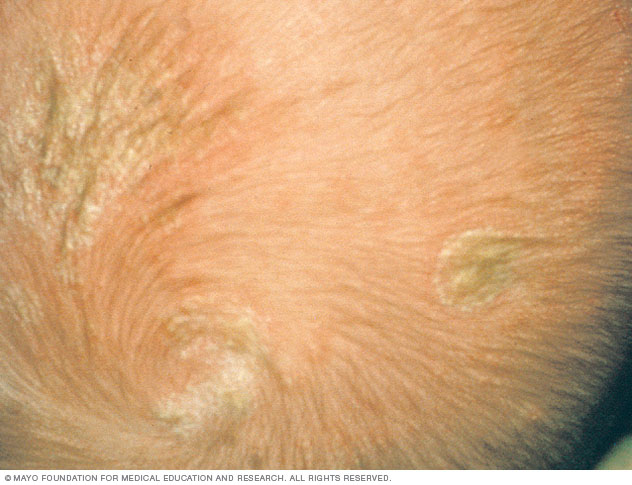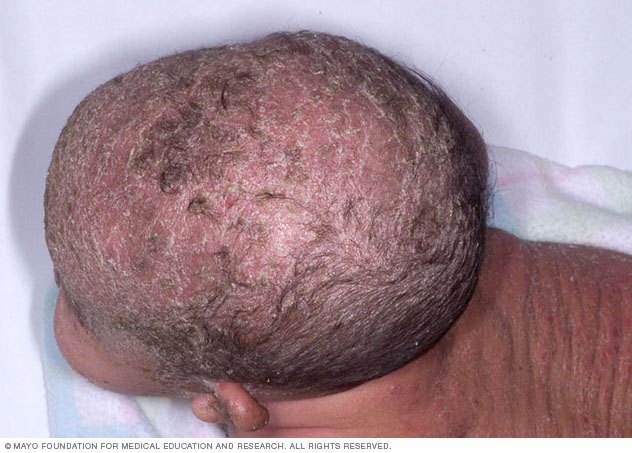Cradle cap
Overview
Cradle cap causes crusty or oily scaly patches on a baby's scalp. The condition isn't painful or itchy. But it can cause thick white or yellow scales that aren't easy to remove.
Cradle cap usually clears up on its own in weeks or a few months. Home care measures include washing your baby's scalp daily with a mild shampoo. This can help you loosen and remove the scales. Don't scratch cradle cap.
If cradle cap doesn't stop or seems serious, your baby's doctor or other health care professional may suggest a medicated shampoo, lotion or other treatment.

On white skin, cradle cap is characterized by scaly patches on a baby's scalp. You may notice thick, yellow patches of skin. The patches may be crusty or greasy.

On Black or brown skin, cradle cap appears as patchy scaling or thick crusts on the scalp and greasy skin covered with flaky white or yellow scales. Cradle cap usually doesn't bother the infant.
Symptoms
Common symptoms of cradle cap include:
- Patchy scaling or thick crusts on the scalp.
- Oily or dry skin covered with flaky white or yellow scales.
- Skin flakes.
- Mild inflammation.
Similar scales also may be present on the ears, eyelids, nose and groin.
Cradle cap is common in newborns. It usually isn't itchy.
Cradle cap is the common term for infantile seborrheic dermatitis. It's sometimes confused with another skin condition, atopic dermatitis. A major difference between these conditions is that atopic dermatitis can be very itchy.
When to see a doctor
See your baby's doctor or other health care professional if:
- You've tried treating cradle cap at home without success.
- The patches spread to your baby's face or body.
Causes
The cause of cradle cap isn't known. One factor may be hormones that pass from the mother to the baby before birth. These hormones can cause oil glands and hair follicles to make too much oil. This oil is called sebum.
Another factor may be a fungus called malassezia (mal-uh-SEE-zhuh) that grows in the sebum along with bacteria. Antifungal treatments often help control symptoms. This supports the idea that malassezia is a cause. An example of an antifungal treatment is ketoconazole.
Cradle cap isn't contagious, and it's not caused by poor hygiene.
Risk factors
Cradle cap is very common in babies. There are no known risk factors for it.
Prevention
Shampooing your baby's hair every few days can help prevent cradle cap. Use a baby shampoo unless your baby's doctor or other health care professional suggests a stronger product.
Treatment
Cradle cap may not need medical treatment, as it often goes away if you use the home care tips below. If these home care tips don't work, talk with your baby's doctor about products that might help, such as a low-potency hydrocortisone cream or a shampoo with 2% antifungal ketoconazole medicine. Be sure the shampoo doesn't get in your baby's eyes, as it may hurt.
If you want to try the type of cortisone or antifungal creams you can buy at the store without a prescription, talk with your baby's doctor or other health care professional first. Some of these products can be too strong for a baby's skin. Dandruff shampoos that contain salicylic acid aren't recommended for use in babies either because that ingredient can be absorbed through the skin.
Lifestyle and home remedies
The following home care tips may help you control the symptoms of cradle cap:
- Gently rub your baby's scalp with your fingers or a washcloth to loosen the scales. Don't scratch.
- Wash your baby's hair once a day with baby shampoo. Loosen the scales with a small, soft-bristled brush or fine-toothed comb before rinsing off the shampoo.
- If the scales don't loosen easily, rub petroleum jelly or a few drops of mineral oil onto your baby's scalp. Let it soak into the scales for a few minutes, or hours if needed. Then brush and shampoo the hair as usual. Be sure to rinse well. If you leave in the oil, the cradle cap may get worse.
- When the scales are gone, wash your baby's hair two or three times a week with a mild shampoo to prevent scale buildup.
Preparing for an appointment
What you can do
If your baby's cradle cap doesn't improve with home care measures or starts to spread, make an appointment for medical care. Your baby's doctor or other health care professional will want to know:
- How long your baby has had cradle cap.
- What you've done to treat it.
- How often you shampoo your baby's hair.
- What products you've tried.
Last Updated Jan 6, 2024
© 2024 Mayo Foundation for Medical Education and Research (MFMER). All rights reserved. Terms of Use





